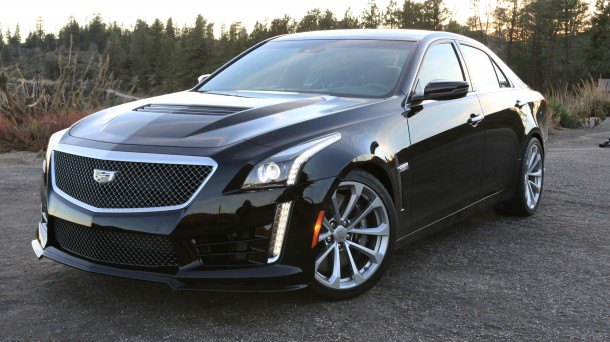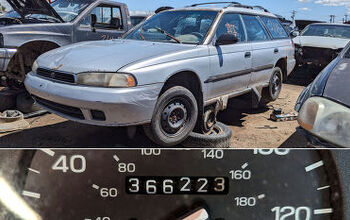2016 Cadillac CTS-V Review: More Than Brute Force
2016 Cadillac CTS-V
It’s been almost two decades since BMW unleashed the E39 M5 on the motoring public, and the sport sedan segment has chased its ghost ever since. Not long after the BMW was crowned mythic perfection, Cadillac made a substantial shift in its development focus to court younger, more performance-minded buyers.
Since then, Cadillac has generously pilfered the Corvette program parts bin to move the brand away from the retirement home and onto America’s non-existent Autobahn. In the meantime, BMW’s M Division has set its playbook on fire and begun heaping content onto its performance models.
When the second generation CTS-V broke the production sedan lap record at the Nurburgring in 2008, it became clear that the conversation was really starting to change.
The subsequent eight years find us in the middle of the second golden age of motoring, as shown by the revelation that this new 640 horsepower super sedan is somehow not the most powerful American four-door you can now buy off the showroom floor.
Powertrain
That isn’t to say that it’s a terrible gearbox — it certainly isn’t — but in terms of driver engagement, it does leave something on the table.
The rest of the car does not though. Make no mistake, the CTS-V is an incredibly well sorted high performance machine that effectively showcases the engineering prowess that Cadillac now has at its disposal.
The Caddy’s 6.2-liter is yanked from the C7 Corvette Z06, here tuned to the aforementioned 640 horsepower and 630 pounds-feet of torque. While it doesn’t have the same level of absurdity as the supercharged mill in the Dodge Charger Hellcat — particularly in the realm of low-end torque — it’s still a legitimate missile, capable of getting the CTS to 60 mph from a standstill in 3.7 seconds. The Mopar gets the job done with brute force and bravado, but the CTS-V is far more composed and dignified about its prodigious thrust.
While the Germans have embraced turbocharging wholeheartedly, the CTS-V’s supercharged mill provides linear power delivery that turbos strive to replicate but rarely can. It comes at a cost though: the CTS-V that I took around Big Willow last year dialed back power during my first hot lap due to dangerously high engine temperatures. To be fair, the car was tracked with only short breaks between three-lap stints, but I was nowhere near running at 10/10ths even when the car was cooperating with me. I doubt anyone else I shared the car with that day was either. Achilles, how’s your heel?
Drive
While it’s certainly no featherweight, it’s worth noting that the Cadillac is still several hundred pounds lighter than both the current M5 and the Mercedes-AMG E63 S, while also boasting more output than both. It also stops shocking well due to the beefy Brembo brake system, which can bring the car to a halt from 60 miles per hour in a mere 99 feet.
This, along with a staggered set of Michelin Pilot Super Sport summer tires and added structural reinforcement that makes the CTS-V 20-percent stiffer than the standard car, equates to an incredible performer considering its size.
Infotainment
Truth be told, the pitfalls of CUE are largely avoidable both by physical buttons on the steering wheel and using the touch screen, though the frustrations will quickly return when you need to adjust anything HVAC related.
The CTS-V’s 12.3-inch configurable gauge cluster looks sharp and is easy to read, while the 8-inch touchscreen on the center stack is reasonably responsive, though not quite snappy. Either way, Cadillac gets bonus points for including navigation functionality and the Bose surround sound system as standard on the CTS-V.
Exterior
It’s a fine line to walk, but the V treatment suits the CTS well, as the vented carbon fiber hood, reworked air intakes and subtle rear diffuser serve both form and function without looking tacky or overwrought.
That said, the hood bulge, low hanging front fascia, quad exhaust tips, and big forged wheels make it clear that this is not your granddaddy’s DTS. While it may fly under the radar of the average motorist, interested parties will be able to tell what this is upon first glance.
Interior
Like the ATS-V, the CTS-V doesn’t stray far from the aesthetic of the standard model, though the optional Recaro buckets do bring with them a sense of occasion while maintaining grand touring levels of comfort.
In general, while the CTS-V remains a step or two behind the offerings from Mercedes-AMG and Audi in terms of overall interior swankiness, it’s also nothing to apologize for at this point. Considering that the CTS-V undercuts the price tag of everything else in its class by at least ten grand, some concessions in interior quality are forgivable.
Bottom Line
At this point, the target is no longer on BMW’s back. When it comes to luxury performance — at least where the latter is of greater importance — Cadillac is now the one to beat.
General Motors provided the car, insurance, and tank of fuel for this review.
[Images: © 2016 Bradley Iger/The Truth About Cars]
More by Bradley Iger
Latest Car Reviews
Read moreLatest Product Reviews
Read moreRecent Comments
- Whynotaztec Like any other lease offer it makes sense to compare it to a purchase and see where you end up. The math isn’t all that hard and sometimes a lease can make sense, sometimes it can’t. the tough part with EVs now is where is the residual or trade in value going to be in 3 years?
- Rick T. "If your driving conditions include near-freezing temps for a few months of the year, seek out a set of all-seasons. But if sunshine is frequent and the spectre of 60F weather strikes fear into the hearts of your neighbourhood, all-seasons could be a great choice." So all-seasons it is, apparently!
- 1995 SC Should anyone here get a wild hair and buy this I have the 500 dollar tool you need to bleed the rear brakes if you have to crack open the ABS. Given the state you will. I love these cars (obviously) but trust me, as an owner you will be miles ahead to shell out for one that was maintained. But properly sorted these things will devour highway miles and that 4.6 will run forever and should be way less of a diva than my blown 3.8 equipped one. (and forget the NA 3.8...140HP was no match for this car).As an aside, if you drive this you will instantly realize how ergonomically bad modern cars are.These wheels look like the 17's you could get on a Fox Body Cobra R. I've always had it in the back of my mind to get a set in the right bolt pattern so I could upgrade the brakes but I just don't want to mess up the ride. If that was too much to read, from someone intamately familiar with MN-12's, skip this one. The ground effects alone make it worth a pass. They are not esecially easy to work on either.
- Macca This one definitely brings back memories - my dad was a Ford-guy through the '80s and into the '90s, and my family had two MN12 vehicles, a '93 Thunderbird LX (maroon over gray) purchased for my mom around 1995 and an '89 Cougar LS (white over red velour, digital dash) for my brother's second car acquired a year or so later. The Essex V6's 140 hp was wholly inadequate for the ~3,600 lb car, but the look of the T-Bird seemed fairly exotic at the time in a small Midwest town. This was of course pre-modern internet days and we had no idea of the Essex head gasket woes held in store for both cars.The first to grenade was my bro's Cougar, circa 1997. My dad found a crate 3.8L and a local mechanic replaced it - though the new engine never felt quite right (rough idle). I remember expecting something miraculous from the new engine and then realizing that it was substandard even when new. Shortly thereafter my dad replaced the Thunderbird for my mom and took the Cougar for a new highway commute, giving my brother the Thunderbird. Not long after, the T-Bird's 3.8L V6 also suffered from head gasket failure which spelled its demise again under my brother's ownership. The stately Cougar was sold to a family member and it suffered the same head gasket fate with about 60,000 miles on the new engine.Combine this with multiple first-gen Taurus transmission issues and a lemon '86 Aerostar and my dad's brand loyalty came to an end in the late '90s with his purchase of a fourth-gen Maxima. I saw a mid-90s Thunderbird the other day for the first time in ages and it's still a fairly handsome design. Shame the mechanicals were such a letdown.
- FreedMike It's a little rough...😄











































Comments
Join the conversation
Yes,apparently the difference between 4145 and 4285 is several hundred.
Hmmm... GM spins the hell out of that little 1.8L TVS supercharger, its great for giving the car a big swell of torque down low but I imagine its contributing a lot of heat when the car is being tracked as I'd guess its spending time on the compressor map where efficiency drops off and the air is just being uselessly heated. I don't remember the C6 ZR1 having this sort of trouble with its larger 2.3L supercharger and it made more power. Its puzzled me why GM went with the 1.8L supercharger and spins it so fast. As I alluded earlier I think its to punch up the bottom end. In combination with a fairly high compression for a forced induction car it makes some terrific numbers relatively low in the RPM range and allow the supercharger to keep up with the engine. IIRC these engines at around 2000 rpm are already making over 500 pound feet of torque (by comparison my car with its larger 2.9L supercharger a bit past 2000 rpm is making 500 pound feet and its slightly over driven as well). The trade off seems to be problems with heat management over time on the track which probably only accounts for a small percentage of Z06 and CTS-V buyers that track the car as opposed to drag racing the car or short squirts on the highway. Still always bad press when an auto journalist rings the car out.